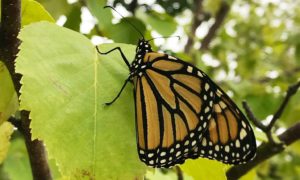Urban spaces provide a unique opportunity for us to help monarchs and other pollinators survive.
In communities across the country, mayors are taking the National Wildlife Federation (NWF) Mayors’ Monarch Pledge. By making the pledge, mayors commit to restore habitat in their communities for the monarch butterfly and encourage citizens to do the same. They identify at least three actions their community will take in the next year, for example: issuing a proclamation, hosting a native plant sale, or directing city property managers to consider using native milkweed where appropriate. They take those actions over the year and report on their community’s progress in meeting those goals.

Why is this so important? Let’s face it. Illinois can be very unwelcoming when it comes to pollinator habitat. With vast agricultural tracts sprayed with pesticides, concrete urban centers, and natural areas few and far between, pollinators have a tough time surviving.
Habitat loss, pesticide use, and climate change all contribute to their reduced numbers. Monarch populations are at an all time low. Once estimated to be around a billion individual insects in the 1990s, today those numbers are staggeringly low — approximately 33 million.
When a community makes an effort to provide habitat, it can make a huge difference.
“Cities matter,” says Abigail Derby Lewis of the Field Museum’s Keller Science Action Center in a recent Chicago Tribune article. “Cities matter a great deal for nature, and this is something that I think is not a mainstream concept, but it is one that is beginning to take hold.”
This is why the National Wildlife Federation’s Mayors’ Monarch Pledge efforts to help the monarch butterfly is so important. In Illinois, mayors across the state are taking part in efforts to help monarchs by taking the pledge.
Communities with mayors who have taken the pledge
Westmont
Cities and towns are like islands in a sea of agricultural land. And where cities work to provide habitat for pollinators, pollinators thrive. It’s a case of build it and they will come.
“Residential pops up far above all other land uses in potential habitat,” Lewis says in the Tribune article. “You walk through a lot of residential areas and it’s like concrete, turf, concrete, turf. There’s not a lot of functional habitat, but there could be.”
Monarchs will soon begin their long journey to their wintering grounds in Mexico. Our gardens are stops on that trip. It doesn’t take much to make space welcoming to pollinators. According to the U.S. Fish and Wildlife Service, choose your location where there is plenty of sun, look at and prep your soil. Choose native, diverse, and untreated (with pesticides) plants. Plant flowers and milkweed, and wait, watch, and water your garden. And begin planning for next year to make your garden a welcoming spot for pollinators.







